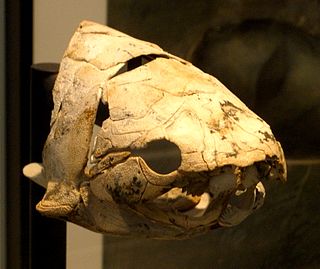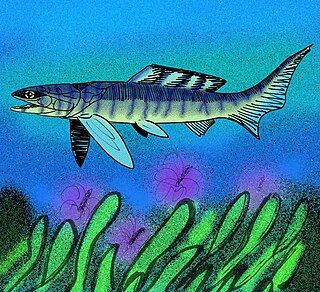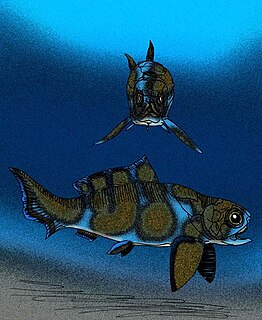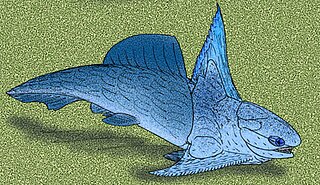 W
WAleosteus eganensis is an extinct arthrodire placoderm fish. Its fossils have been found in the Late Emsian strate of the Sevy Dolomite Formation, in the Egan Range of east-central Nevada, USA. Almost complete fossils belong to juvenile and adult specimens and show a short and broad skull, posteriorly concave.
 W
WAspidichthys is a genus of large, distinctively tuberculated arthrodire placoderm of uncertain affinities from Upper Devonian marine strata in the Eastern United States and Europe.
 W
WAsterolepis is an extinct genus of antiarch placoderms from the Devonian of North and South America and Europe. They were heavily armored flat-headed benthic detritivores with distinctive jointed limb-like pectoral fins and hollow spine. The armor plate gives the Asterolepis a box-like shape. Its pectoral fins are also armored but the caudal and dorsal fin are not. The first fossils were named by M. Eichwald in 1840 after noticing star-like markings on the fossils.
 W
WAsterosteus is genus of rhenanid placoderm from the Eifelian. The type species, A. stenocephalus, is known from an incomplete skull from Middle Devonian strata of Ohio. What may be a second species is described from fragments decorated with star-shaped tubercules from the Eifelian-aged Gebze beds of Turkey.
 W
WBothriolepis was a widespread, abundant and diverse genus of antiarch placoderms that lived during the Middle to Late Devonian period of the Paleozoic Era. Historically, Bothriolepis resided in an array of paleo-environments spread across every paleocontinent, including near shore marine and freshwater settings. Most species of Bothriolepis were characterized as relatively small, benthic, freshwater detritivores, averaging around 30 centimetres (12 in) in length. However, the largest species, B. rex, had an estimated bodylength of 170 centimetres (67 in). Although expansive with over 60 species found worldwide, comparatively Bothriolepis is not unusually more diverse than most modern bottom dwelling species around today.
 W
WCoccosteus is an extinct genus of arthrodire placoderm. Its fossils have been found throughout Europe and North America. The majority of these have been found in freshwater sediments, though, such a large range suggests that they may have been able to enter saltwater. The largest specimens were about 40 centimetres (16 in), although the average length was 20 to 24 centimetres.
 W
WDinichthys herzeri is an extinct, giant, marine arthrodire placoderm from the Late Devonian of Ohio and Tennessee. It was comparable in size, shape, and ecological role to the better-known Dunkleosteus. Originally described in 1868 by John Newberry on the basis of an incomplete skull roof and mandibles, this species remains imperfectly known to this day.
 W
WDiplognathus is a genus of arthrodire placoderm from the Late Famennian Cleveland Shale of Late Devonian Ohio, known only from incomplete fragments of jaws and skulls. What fragments are known suggest that the living animals were large-eyed piscivores with weak, but widely gaping jaws. D. mirabilis is thought to be fairly large, with infragnathals up to 45 centimeters in length. The second species, D. larfargei, was much smaller, with inferognathals averaging about 4 centimeters in length.
 W
WDunkleosteus is an extinct genus of arthrodire placoderm fish that existed during the Late Devonian period, about 358–382 million years ago. The name Dunkleosteus combines the Greek ὀστέον, osteon, meaning "bone", and Dunkle, in honor of David Dunkle of the Cleveland Museum of Natural History. It consists of ten species: D. terrelli, D. belgicus, D. denisoni, D. marsaisi, D. magnificus, D. missouriensis, D. newberryi, D. amblyodoratus, and D. raveri; some of which are among the largest placoderms to have ever lived. The largest species, D. terrelli grew up to 8.79 m (28.8 ft) long and 4 t in weight. Dunkleosteus could quickly open and close its jaw, like modern day suction feeders, and had a bite force of 6,000 N at the tip and 7,400 N at the blade edge. Numerous fossils of the various species have been found in North America, Poland, Belgium, and Morocco.
 W
WEastmanosteus is a fossil genus of dunkleosteid placoderms. It was closely related to the giant Dunkleosteus, but differed from that genus in size, in possessing a distinctive tuberculated bone ornament, a differently shaped nuchal plate and a more zig-zagging course of the sutures of the skull roof.
 W
WGorgonichthys clarki is an extinct arthrodire placoderm of the superfamily Dinichthyloidea. Fossils of G. clarki are found in the Upper Famennian Cleveland Shales of Late Devonian Ohio. G. clarki is estimated to have reached 6 meters in length. However it still may not have been as heavily built as its contemporary Dunkleosteus.
 W
WGymnotrachelus hydei is a large selenosteid arthrodire placoderm known from the Late Famennian Cleveland Shale of Ohio. It was originally reconstructed as physically resembling Selenosteus, with slightly smaller orbits. Later specimens led to a reappraisal, and now G. hydei is thought to have a more gar-like or barracuda-like build.
 W
WHolonema is an extinct genus of relatively large, barrel-shaped arthrodire placoderms that were found in oceans throughout the world from the Mid to Late Devonian, when the last species perished in the Frasnian-Fammian extinction event. Most species of the genus are known from fragments of their armor, but the Gogo Reef species, H. westolli, is known from whole, articulated specimens. According to these specimens, species of Holonema lived by grazing on stony, horn-shaped, stromatolite-like algae called oncholite, apparently by snipping off the points with a specialized snout.
 W
WHomosteus is a genus of flattened arthrodire placoderm from the Middle Devonian. Fossils are found primarily in Eifelian-epoch aged strata of Europe, Canada, Greenland, and Estonia. All of the species had comparatively large, flattened heads with, as suggested by the upward opening orbits, upward-pointing eyes. These adaptations suggest that the various species were benthic predators. A study on Titanichthys, in contrast, suggests that species of Homosteus may have been filter-feeders instead.
 W
WNeophlyctaenius is an extinct genus of placoderm fish, which lived during the Late Devonian period of North America.
 W
WParamylostoma arcualis is an extinct selenosteid arthrodire placoderm from the Late Famennian Cleveland Shale of Late Devonian Ohio. It has a compressed, box-like head and thoracic armor, and large, rounded orbits. However, in comparison with other selenosteids, such as Selenosteus, P. arcualis' orbits were rather small. P. arcualis had smooth jaws that suggest the animal was durophagous.
 W
WPhyllolepididae is one of two families of phyllolepid placoderms. The family, as a whole, is believed to be descended from the Chinese placoderm, Gavinaspis (which forms the other, monotypic family, "Gavinaspididae"). All but two genera are, more or less, restricted to freshwater habitats of the Early to Middle Devonian of Australia. By the Frasnian, the genus Placolepis would spread throughout the world, with fossils being found in Australia, Turkey, Venezuela, and Antarctica, and by the start of the Famennian, phyllolepids would become extinct in Australia, with only species of Phyllolepis surviving in freshwater environments of Europe and North America.
 W
WPhyllolepis is the type genus of Phyllolepida, an extinct taxon of arthrodire placoderm fish from the middle to late Devonian. The species of Phyllolepis, themselves, are restricted to the Famennian-aged freshwater strata of the Late Devonian, around 360 million years ago. Fossils of this genus have been found primarily in Europe and North America. The end of the Devonian saw them disappear in a mass extinction.
 W
WPlacolepis is an extinct genus of phyllolepid placoderm first discovered in New South Wales. Placolepis was the most widespread phyllolepid genus, with fossils found in Australia, Turkey, Venezuela and Antarctica.
 W
WPlourdosteus is an extinct genus of placoderm, which was relatively widespread in Euramerica during the Givetian to Frasnian ages of the Devonian. The name Plourdosteus commemorates the Plourde family at Miguasha.
 W
WProtitanichthys is a genus of comparatively large coccosteid arthrodire placoderm from the Middle Devonian of the eastern United States. Fossils are found primarily in the Eifelian-epoch aged Delaware Limestone of Ohio, and the Lower Givetian-aged Rockport Quarry of Michigan
 W
WRomundina is a small, heavily armored extinct genus of acanthothoracid placoderms which lived in shallow marine environments in the early Devonian (Lochkovian). The name Romundina honors Canadian geologist and paleontologist Dr. Rómundur (Raymond) Thorsteinsson of Calgary, Alberta, Canada. Romundina are believed to have lived on Earth between 400 and 419 million years ago. The closest known relative to Romundina is the acanthothoracid Radotina. The type and only described species is R. stellina.
 W
WSelenosteus brevis is a large selenosteid arthrodire placoderm known from the Famennian Cleveland Shale of Ohio. Scrappy remains from the Frasnian Rhinestreet Shales of Erie County, New York, were attributed by Hussakof and Bryant to this genus in 1919, but, this identification is doubtful. A second species, S. kepleri, was described in 1901, but, not enough differences can be seen between its specimens, and those of the type species to warrant new species status.
 W
WStenosteus is a genus of medium-sized selenosteid arthrodire placoderms known from the Upper Famennian Cleveland Shale of Ohio. Estimated skull lengths range from 6 to 9 centimeters
 W
WTitanichthys is a genus of giant, aberrant marine placoderm from shallow seas of the Late Devonian of Morocco, Eastern North America, and possibly Europe. Many of the species approached Dunkleosteus in size and build. Unlike its relative, however, the various species of Titanichys had small, ineffective-looking mouth-plates that lacked a sharp cutting edge. It is assumed that Titanichthys was a filter feeder that used its capacious mouth to swallow or inhale schools of small, anchovy-like fish, or possibly krill-like zooplankton, and that the mouth-plates retained the prey while allowing the water to escape as it closed its mouth. A study has since confirmed this assumption as its jaws are functionally closer to that of filter feeders like baleen whales and basking sharks, and it appears to have developed from benthic durophagists that became pelagic suspension feeders. This would make it the first (known) large-sized vertebrate filter feeder.
 W
WTurrisaspis elektor is an extinct species of groenlandaspid arthrodire placoderm . It is known only from trunk fragments from the Catskill Formation from the Upper Devonian of Clinton County, Pennsylvania .